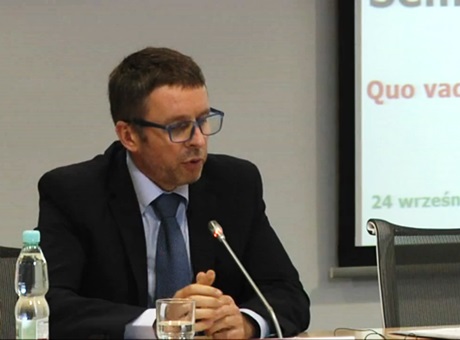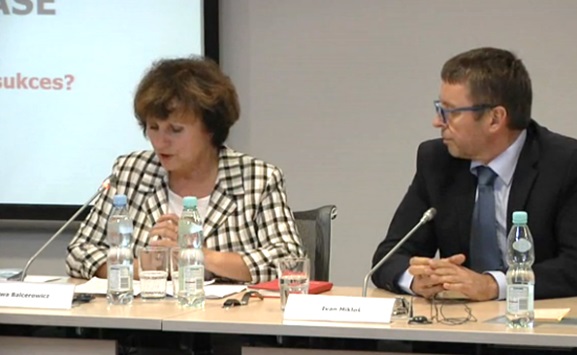01 Oct 2015
Quo vadis, Ukraine? asks Ivan Mikloš during 139th mBank – CASE Seminar
“If I am to point to one most important characteristic of Ukraine it is the fact that it is a country whose level of development is far below its potential” – said Ivan Mikloš, co-founder and president of think-tank MESA10 and a member of the International Advisory Board of National Reform Council of Ukraine, who was the keynote speaker during the 139th mBank-CASE Seminar “Quo vadis, Ukraine? Can it succeed?”, which took place on September 24, 2015.
 In order to illustrate his point, Mr Mikloš compared GDP per capita of Ukraine, Belarus and Poland. Back in the 1990s in all three countries it was roughly the same. In 2013, however, Poland’s GDP per capita was three times as Ukraine’s. As for Belarus, the index value was twice as high as in Ukraine – even though central planning system in Belarus has not been changed much and the country is still semi authoritarian, its economic performance is still significantly better than that of Ukraine.
In order to illustrate his point, Mr Mikloš compared GDP per capita of Ukraine, Belarus and Poland. Back in the 1990s in all three countries it was roughly the same. In 2013, however, Poland’s GDP per capita was three times as Ukraine’s. As for Belarus, the index value was twice as high as in Ukraine – even though central planning system in Belarus has not been changed much and the country is still semi authoritarian, its economic performance is still significantly better than that of Ukraine. Life expectancy is also an important criteria that helps to understand what has been going on in Ukraine for the past 25 years. Between 1990 and 2013 it decreased only in five countries, remained the same in Russia and North Korea, and increased by just one year in another two – Belarus and Ukraine. In Poland, the average life span extended by six years – said Mikloš.
According to him, such a situation is a result of the fact that no institutional, structural or macroeconomic reforms were implemented after gaining the independence form the USSR in December 1991. Incumbents, including president Leonid Kravchuk, claimed that it had been time for building new state and new institutions, not conducting reforms. One of the most dire consequences of such an approach was hyperinflation that reached 10 000%.
Since the country was run by old nomenclature, politicians felt the changes would simply impair their interests, but they were also afraid of the negative effects of the reforms resulting in nation’s dissatisfaction. According to Mikloš this led to oligarchization.
Currently, the share of property of the 50 richest people in GDP in US is 4.5 per cent. In Russia it is 16.5 per cent and in Ukraine 46 per cent. In other words half of the Ukraine’s GDP is in the hands of just 50 people. A major source of income for the oligarchs was the energy sector, in which for a long time prices had been regulated both for households and commercial companies. In fact, prices for households have not been liberalized until very recently. This created a big opportunity for an arbitrage. Until April 2015,the price of gas for households stood at 12% of the real market price; many entities would buy this cheap energy and re-sell it to companies for normal market prices. 

Mr. Mikloš also pointed to state-owned enterprises (SOEs) sector as a challenge for the country’s economy – in Ukraine there are over 3 300 SOEs, but only 60% of them are operating and their output amounts to 10% of Ukraine’s GDP.
As far as the ongoing reforms are concerned, the political change is the biggest achievement in Mr. Mikloš’s opinion. In 2014 both presidential and parliamentary elections were held. Now about 50% of MPs are new to the parliament and ruling coalition consist of four parties. Alas, despite the fact that the coalition has a majority of 285 seats, it lacks the unity. As a result, since the appointment of government in December 2014, only 36% of reform proposals were passed. When Poland underwent transformation, the ratio was almost 100%. This slow pace of reforms is the biggest challenge for Ukraine – he said.
During the lively debate that ensued after the presentations, the participants to the seminar discussed the role of the media in Ukraine’s public life and oligarchs’ influence on them, as well as the progress of reforms in the field of legislative system framework.
